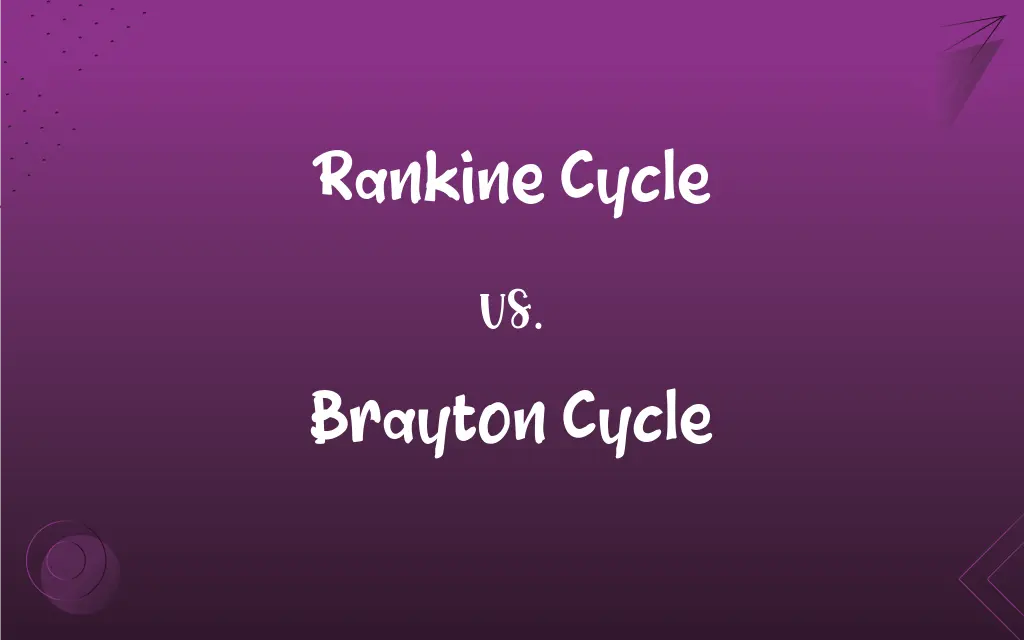Rankine Cycle vs. Brayton Cycle: What's the Difference?
Edited by Aimie Carlson || By Harlon Moss || Published on January 1, 2024
Rankine Cycle is a heat engine cycle using steam for power generation. Brayton Cycle is a gas turbine cycle used in jet engines and power plants.

Key Differences
The Rankine cycle is a steam-based thermodynamic cycle used primarily in power plants, whereas the Brayton cycle is a gas turbine cycle commonly found in jet engines and some power plants. Both cycles convert heat into mechanical work, but they differ in working fluids and processes.
In the Rankine cycle, water is heated, evaporated, and then expanded through a turbine, while in the Brayton cycle, air is compressed, heated, and expanded. The Rankine cycle uses phase changes of water to absorb and reject heat, while the Brayton cycle relies on continuous gas compression and expansion.
Efficiency in the Rankine cycle is often enhanced by superheating and reheating steam, while the Brayton cycle's efficiency can be improved by increasing the compression ratio and employing intercooling and reheating. Both cycles have regenerative options, but they apply them differently.
The Rankine cycle typically operates at lower temperatures and pressures than the Brayton cycle, making it more suitable for stationary power plants. The Brayton cycle, with its high power-to-weight ratio and ability to operate at high temperatures, is ideal for aircraft engines.
The Rankine cycle is known for its use in coal, nuclear, and geothermal power plants, while the Brayton cycle is synonymous with modern aviation and gas turbine power plants. Both cycles are pivotal in energy conversion but serve different applications based on their unique characteristics.
ADVERTISEMENT
Comparison Chart
Working Fluid
Water/Steam
Air/Gas
Typical Use
Power Plants
Jet Engines
Efficiency Method
Superheating
Compression
Temperature
Lower
Higher
Application
Stationary
Mobile
ADVERTISEMENT
Rankine Cycle and Brayton Cycle Definitions
Rankine Cycle
A steam-based cycle commonly used in coal and nuclear power plants.
The Rankine cycle plays a crucial role in the global energy sector.
Brayton Cycle
A thermodynamic cycle used in gas turbines and jet engines.
The jet's engines operate on the Brayton cycle, utilizing high-speed air compression and expansion.
Rankine Cycle
A heat engine cycle integral to conventional power generation systems.
Nuclear reactors often employ a Rankine cycle for electricity production.
Brayton Cycle
A continuous combustion cycle used for high-power applications.
Modern jet engines leverage the Brayton cycle for its high thrust output.
Rankine Cycle
A process involving the phase change of water to generate work.
The Rankine cycle's efficiency is evident in its widespread use in thermal power stations.
Brayton Cycle
A cycle commonly used in aircraft engines and some power plants.
Gas turbine power plants often use the Brayton cycle for electricity generation.
Rankine Cycle
A thermodynamic cycle used for power generation in steam turbines.
The power plant utilizes a Rankine cycle to convert thermal energy into electricity.
Brayton Cycle
A gas turbine cycle ideal for applications requiring a high power-to-weight ratio.
The Brayton cycle's characteristics make it perfect for aerospace engineering.
Rankine Cycle
A cycle where water is heated, evaporated, expanded, and then condensed.
Engineers optimize the Rankine cycle for maximum efficiency in energy plants.
Brayton Cycle
A cycle involving air compression, heating, and expansion for power.
The power plant's efficiency is enhanced through the Brayton cycle's advanced design.
FAQs
What is the Rankine cycle?
It's a steam-based thermodynamic cycle used for generating power in steam turbines.
How does the Brayton cycle work?
It compresses air, heats it up through combustion, and then expands it for power generation.
What are the main differences between the Rankine and Brayton cycles?
The Rankine cycle uses water as the working fluid and includes phase changes, while the Brayton cycle uses air and operates through continuous gas compression and expansion.
How does the Rankine cycle work?
It involves heating water into steam, expanding it through a turbine, and then condensing it back to water.
Where is the Rankine cycle typically used?
It's commonly used in coal, nuclear, and geothermal power plants.
Can the Rankine cycle be used in transportation?
It's generally not used in transportation due to its lower power-to-weight ratio.
Where is the Brayton cycle typically used?
It's primarily used in jet engines and gas turbine power plants.
What is the Brayton cycle?
It's a gas turbine cycle used in jet engines and some power plants.
How is efficiency achieved in the Brayton cycle?
By increasing the compression ratio and employing intercooling and reheating techniques.
What are the environmental impacts of the Brayton cycle?
In jet engines, it leads to greenhouse gas emissions, but efficiency improvements are reducing these impacts.
How is efficiency achieved in the Rankine cycle?
Efficiency is improved through superheating, reheating, and regenerative processes.
Can the Rankine cycle operate at high temperatures?
It operates at lower temperatures compared to the Brayton cycle.
Is the Brayton cycle suitable for stationary power generation?
It's more suited for applications requiring high power-to-weight ratios, like aircraft engines.
What makes the Brayton cycle ideal for jet engines?
Its ability to handle high temperatures and provide a high power-to-weight ratio.
What are the environmental impacts of the Rankine cycle?
It depends on the fuel used; coal-fired plants have significant emissions, while nuclear and geothermal are cleaner.
Can the Brayton cycle be used in hybrid systems?
Yes, it's often used in combination with other cycles for improved efficiency.
What advancements are being made in the Rankine cycle?
Advances include higher efficiency turbines and integration with renewable energy sources.
What future trends are shaping the Brayton cycle?
Trends include advancements in materials for higher temperature operation and integration with renewable energy systems.
What type of power plants use the Rankine cycle?
Mostly coal, nuclear, and geothermal power plants.
Is the Rankine cycle efficient for small-scale applications?
It's less efficient for small-scale applications due to the complexity of steam systems.
About Author
Written by
Harlon MossHarlon is a seasoned quality moderator and accomplished content writer for Difference Wiki. An alumnus of the prestigious University of California, he earned his degree in Computer Science. Leveraging his academic background, Harlon brings a meticulous and informed perspective to his work, ensuring content accuracy and excellence.
Edited by
Aimie CarlsonAimie Carlson, holding a master's degree in English literature, is a fervent English language enthusiast. She lends her writing talents to Difference Wiki, a prominent website that specializes in comparisons, offering readers insightful analyses that both captivate and inform.






































































